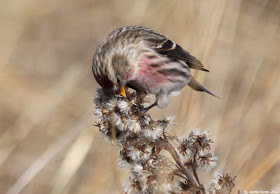First the pictures. Here's a visualization of the behavior. I think you'll be able to tell that both birds were pretty invested in defending the pool!
And here are two images of Surfbirds bathing in high pools:
After taking a bath, the birds roosted on nearby rocks. For comparison, the Surfbird is on the left and the Black Turnstone is on the right:
And now for the recordings. Below are three short recordings of the Surfbird vocalizing. There are large waves breaking in the background, but listen for the high-pitched squeals. (You may need to turn up the volume.)
I can't find much information about Surfbird calls during the non-breeding season, so this is an opportunity to document what they sound like during the winter while defending a bathing site. (For the record, this is the individual on the left in the first two photos.)
Here's hoping for a year full of new and interesting natural history observations!
Happy New Year!





















































